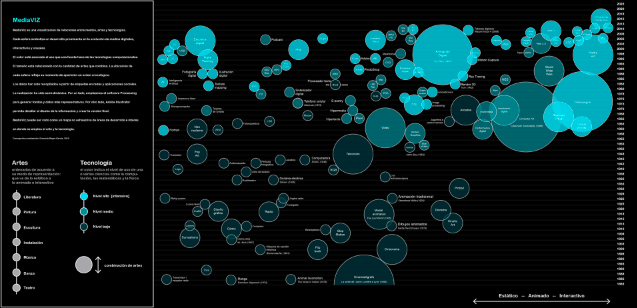MediaViz
visualizing relationships between media, arts and technology
Everardo REYES-GARCIA. July, 2010

Project description
MediaViz is a visualization of relationships between media, arts and technology.
Each sphere stands for a prominent development in the evolution of digital, visual, and interactive media. The color is associated to the importance conferred to information technologies in the use and production. Clearer means more IT. The size is calculated by the amount of arts required to create content with it. The arts we identify are mainly literature, painting, sculpture, installation, music, dance, and theatre. Regarding the spatial location on the plane, the Y position is determined by the chronological time when it was first introduced (although in some cases we consider a major development instead of its first appearance). Finally, the X position goes from static (left) to animated and interactive (right) modes of representation of the media.
Data was collected from tags found in popular Web sites such as Delicious and Wikipedia. In those sites, tags are commonly clustered and thus allow for observing relations. We also took into account information from media databases, timelines, and bibliography.
The visualization was produced in two parts. First, we used Processing to generate backgrounds, colors, and locating the biggest spheres. Second, we refined design with Adobe Illustrator, adding more objects and preparing the final version.
In a way, MediaViz can be seen as a non-exhaustive map of areas of interest and development where art and technology is employed.
Background and motivation
I have always been fascinated with the invention of new objects and new ways for expression. In my readings, I commonly highlight passages that refer to the born of new media or to the moment where an object evolves or changes its semantic meaning. When I started working on my PhD in 2003 at Hypermedia Department, University of Paris VIII, I experienced the need for tracing ICT. Soon it became something like deconstructing media. In this manner, I created lots of spreadsheets documenting media accordingly to years, places, people, companies, and relations between them.
Recently, I accepted an appointment as program director of the BA in Animation and Digital Art at Tecnológico de Monterrey in Toluca, Mexico. This BA started 3 years ago with an ambitious goal: to prepare students fluent in both art and tech; capable of designing and coding; painting and hacking. As it may be thought, "Animation and Digital Art" is an umbrella term that requires detail. On the one hand, "Digital Art" is studied as a contemporary and experimental way of expression; its origins may be traced back to 1968 when the exhibition Cybernetic Serendipity opened in London. However, professionals of industry often see digital art as art direction: sketching, character design, graphic design, matte painting, etc. On the other hand, the notion of "digital animation" is loaded with references to Pixar Studios or VFX. We strongly believe the possibilities of animation and digital art are wider. New digital media is becoming interdisciplinary. Artists and designers make extensive use of computing, but there is also need for analyzing methods. Geography, economy, biotechnology, mechatronics, humanities are some examples where IT and design gain presence. From this perspective, 3D digital animation, 3D digital modeling, HCI, discrete mathematics, physics, physical interfaces, semiotics, drawing, sculpting, storyboarding, storytelling, meet at a crossing point in our contemporary world. MediaViz assists in showing to students, and public in general, a broaden panorama of digital media.
Downloads
Small [JPG / 655 Kb.] | Medium [JPG / 2.8 Mb] | Large [JPG / 13.5 Mb]